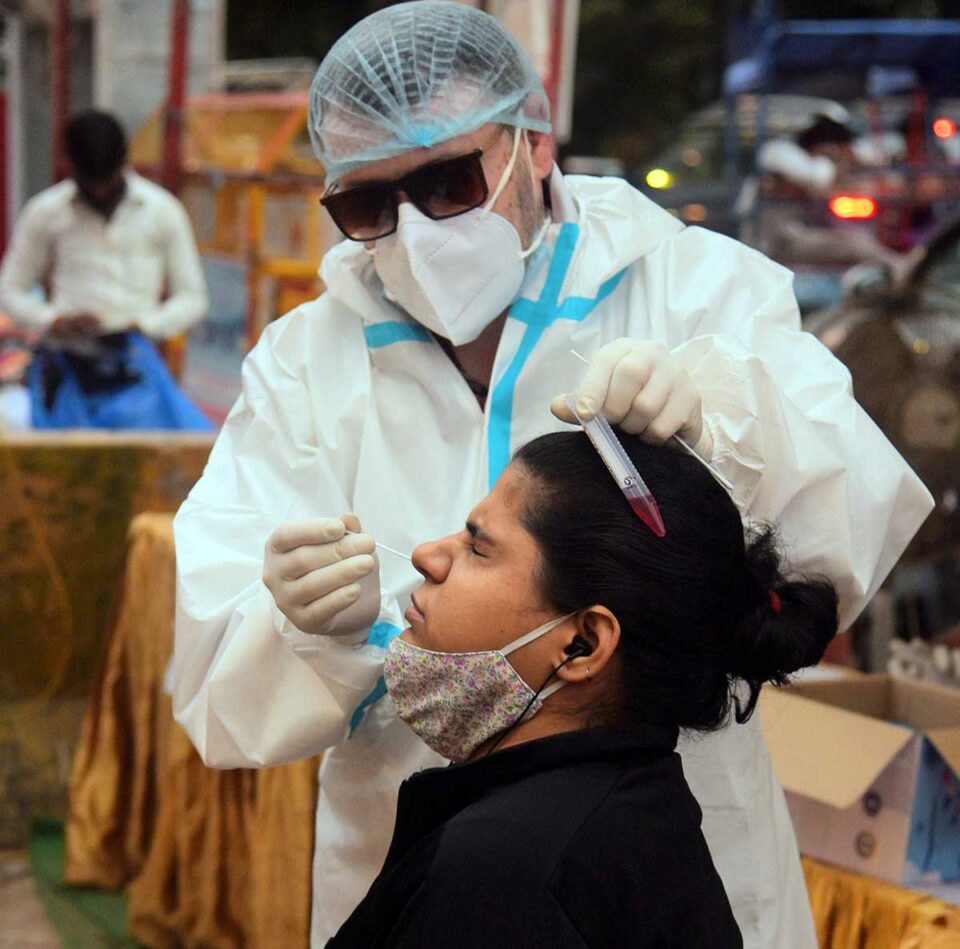IMAGE: A medic collects swab samples for a COVID-19 RT PCR test at Lajpat Nagar market in New Delhi, November 16 2020. Photograph: Prateek Kumar/ANI Photo
Our life is being ruled by a super shocker.
Day by day, SARS-CoV-2, the virus that causes COVID-19, is showing itself to be the joker in the pack of viruses.
Unpredictable.
Nonconformist.
Maverick.
Equipped with invincible characteristics and capable of dangerous moves, knowledge of the slippery virus shifts daily.
One day it’s said to be carried by aerosol particles.
The next day it is confirmed to be airborne too.
Some say it lives on plastic and steel for up to nine days.
Now the latest prediction is 28 days for steel, as well as glass, cellphone screens and currency.
Does it leave your body in 14 days?
Or can it loiter about, greedily freeloading on your system, for months together?
Can it return to take up residence for further viral stints?
It’s pretty hard to keep up with the devilish twists and turns of the coronavirus story.
Has there ever been a virus quite like SARS-CoV-12 before?
Professor Rajesh Khanna, who feels, dear readers, his name may hold your attention so you will read what he has to say, working with his team in a lab in Tucson, Arizona, has discovered a new superpower, sigh, of the COVID-19 virus.
Attached to the University of Arizona Health Sciences’s College of Medicine, he is at this institute the professor of anesthesiology, professor of neuroscience of the graduate interdisciplinary program, the professor of pharmacology and professor at the university’s BIO5 Institute, a research body.
A specialist in the chemical basis of chronic pain, the professor earned his PhD in physiology, MS in pharmacology and a BS in toxicology from the University of Toronto and worked on post-doctoral fellowship at UCLA.
Professor Khanna published, in several journals including PAIN, research that suggested that pain may not be an early symptom of COVID-19 or maybe reduced, because the COVID-19 virus’s surface spike protein ‘silences the body’s pain signalling pathways’.
That means, in simpler terms, that the COVID-19 virus has the power to quietly enter your body, without causing pain via symptoms, because it craftily manipulates your pain response.
And that is the reason for so many asymptomatic cases of COVID-19.
The virus’s modus operandi or technique is simple.
There is a receptor protein in the neurons of your body called neuropilin-1.
Neuropilin-1 routinely ties up with another factor called VEGF-A to notify pain.
Now COVID-19 virus sometimes opts to enter your body via neuropilin-1, instead of the usual lungs ACE-2 receptor doorway, and its surface protein mimics VEGF-A to combine with neuropilin-1 to secretly gain entry.
And when the surface protein of the COVID-19 virus combines, in flamboyant imposter style, with neuropilin-1, in place of the real McCoy VEGF-A, instead of signalling pain, it does the opposite and slyly silences it.
This characteristic ensures that there is a higher spread of COVID-19 by people not feeling the pain of the illness ie the asymptomatics.
Professor Khanna and his team, who are deeply familiar with both neuropilin-1 and VEGF-A through their years of study, worked on a research project — at “breakneck speed” given the urgency that governs our present times where history is being made every day and medical research related to COVID-19 is galloping ahead furiously — to outline exactly how the COVID-19 virus silences pain.
In the first part of an enlightening interview to Vaihayasi Pande Daniel/KhabriBaba.com, Proessor Rajesh Khanna explains the importance of this discovery and what consequences it might have.
IMAGE: The surface protein of the COVID-19 virus combines, in flamboyant imposter style, with neuropilin-1, in place of the real McCoy VEGF-A, instead of signalling pain, it does the opposite and slyly silences it. All photographs: Kind courtesy University of Arizona Health Sciences
Can you tell us a little bit about neuropilin-1 and VEGF-A?
And the action between them?
The COVID-19 virus seems to mimic VEGF-A in order to tie up with neuropilin-1 and it behaves like a cuckoo adding its eggs to the nest of other birds?
Up to now, scientists across the world have thought that the ACE-2 (angiotensin converting enzyme receptors found also in the lungs) are sort of the main doorway through which the SARS-CoV-2 virus comes into the body.
In early July, there were a couple of papers deposited on BioRxiv — a preprint server for biology — that my colleagues and I came across, that painted a different picture, identifying a protein called neuropilin-1 as another gateway through which the virus may enter our cells.
We started exploring that.
The reason it piqued our attention was because neuropilin-1 by itself had never been linked to pain.
It just so happened that, for the past two years, in my lab, we had been studying neuropilin-1 signalling independently.
We didn’t know that SARS-CoV-2 virus existed.
Under normal conditions, the neuropilin-1 protein controls the growth of blood vessels, as well as the growth and survival of neurons.
But there is another factor called VEGF-A (vascular endothelial growth factor A).
It’s basically involved in cancerous tumors because of its ability to promote growth.
It’s angiogenic factor — it causes blood vessel growth.
When neuropilin-1 binds to the naturally-occurring protein VEGF-A, this triggers pain signals.
This signal is transmitted via the spinal cord into higher brain centres to cause the sensation we all know as pain.
Staring at this jigsaw puzzle — neuropilin-1 and VEGF-A and neuropilin-1 and spike — we wondered if there was a link between spike (a protein found on the surface of COVID-19) and pain.
So much like a cuckoo laying an egg in the nest of others, spike protein was the new egg being laid in the neuropilin-1 nest.
Normally, the neuropilin-1 nest would be filled with VEGF-A, which would initiate pain.
But instead, the nest is incubated with spike protein, which sits exactly where VEGF-A would normally sit, and this leads to a complete cessation of pain signalling.
And when we figured that out, we said: ‘Oh my goodness, this is amazing’ because in this eureka moment we thought that we could connect spike to the pain pathway.
And that really led to this whole series of studies.
This behaviour between the virus’ spike protein and neuropilin-1 does it happen with other viruses?
Or is it peculiar to this SARS-CoV-2 virus?
That’s a great question.
You’re actually right.
The virus has many proteins, including a protein called spike, which has different little modules or different pieces to it.
And one of the pieces, which is needed for binding to various receptors on the host cells, shares similarity with other viruses.
For example, this spike protein is the same as in Ebola*.
This is pretty crazy, right?
So, there are other viruses that share that same little piece to enter into cells.
Now, that’s quite remarkable, because it means that potentially, those viruses could be using the same mechanism to enter via neuropilin-1, which is what is used by SARS-CoV-2.
So, the greater implication of our finding is that maybe some of those other diseases that are caused by these other viruses share a similar mechanism, and in the initial stages, these viruses too are fooling people into believing that they’re okay, in order to spread the viruses more.
IMAGE: Professor Rajesh Khanna.
But what about the first SARS* or SARS-CoV-1?
Does its spike protein create the same action with neuropilin-1?
No, it does not.
Great question.
It (this coronavirus) has evolved somehow.
It does not.
So, MERS* (Middle Eastern respiratory virus) does not, but Ebola* does, and a couple others as well, but not SARS-CoV-1 that came about 18 years ago.
What is connection between a virus being asymptomatic and the action of neuropilin-1 and the spike protein?
Yes, this is where the story gets super interesting.
We asked ourselves as to why this virus was spreading so much.
Reports were being published that showed that there was a lot of asymptomatic spread of the virus.
And some also from pre-symptomatic or mildly symptomatic people.
So, what that meant to us was that there was a window of time before these people contracted full-blown or symptomatic COVID-19.
This window, likely between two to 12 days, was a period during which they don’t know they have COVID-19 and so unwittingly spread the virus.
That’s really where our thinking was — that this could be one of the key reasons why there’s so much spread.
Because in the early stages what we hypothesised and are showing in our published paper — at least in rodents for now — is that the virus is giving you a sense of some sort of analgesia (pain relief).
By masking your pain, it maybe fooling you and letting you think you’re okay.
So that’s why you’re spreading it, because you don’t know you have the virus.
I read that sometimes HIV and flu can be asymptomatic.
Does it use a similar mechanism to enter the body via the connection between the spike protein and neuropilin-1?
That’s a good question.
I don’t know, we’ve not tested that.
But that would be highly provocative.
The flu probably uses a similar mechanism as COVID-19.
But HIV, I don’t know enough to comment on that.
The flu, I would reckon has a similar mechanism.
Why do so many people get flu, right?
One simple hypothesis could be that it is highly contagious it’s allowing people to communicate or transmit it without knowing.
So maybe, it’s advantageous for the virus to have that feature, right?
As to HIV, I don’t know because the transmission is through different means, so I won’t be able to answer that.
One has learnt a lot about the ACE-2 protein and how the COVID-19 virus latches on to it.
And now you’re speaking about neuropilin-1 and adding it as a doorway for the virus to enter into the body.
Could it be that there are still more proteins out there to which this virus could latch onto?
And this is not the end of the story?
Absolutely.
Wonderful question.
Absolutely, this is not the end of story by any means.
So, since our publication, confirming and showing that neuropilin-1 is being used by the COVID-19 virus to enter, in my count, as we speak today, at least here in the US there are four proteins with which the virus enters.
They are ACE2, neuropilin-1, PIKFyve kinase and CD147.
And, I would say, we are likely to hear about more in the months ahead.
As more and more research is being done, we’ll find more.
Your research has shown that when the COVID-19 virus teams up with neuropilin-1, pain is not felt and the person is asymptomatic.
Is the reverse true ie that a person is symptomatic when COVID-19 teamed up with ACE-2 to enter the body?
Why are some people asymptomatic and not feeling pain and why are some people symptomatic and feeling pain?
Did the virus use some other pathway to latch on?
That’s again a wonderful question.
You’re asking just the right questions.
Even in our research we are trying to grapple with that.
Absolutely.
So, you’re right, maybe that the number and quantity of each doorway is what determines pain versus any other symptom of COVID-19.
In other words, how much ACE-2 versus neuropilin-1 in your body and whether neuropilin-1 is preferentially engaged by the virus could determine whether you have this initial masking of pain.
This is being borne out in human reports.
Since the publication of our paper, I’ve gotten emails from across the world with people suffering chronic pain from various things, from injuries, from car accidents, to diseases, that had their pain gone because they happened to contract COVID-19.
This is pretty astonishing!
Oh!?
Amazing, yes!
Their pain was completely gone as soon as they contracted COVID-19.
It goes even further.
Once COVID-19 was resolved, the pain came back.
And more remarkably, in some, even after they recovered from COVID-19, their pain did not return!
But it resolved it temporarily and did they suffer more with COVID-19?
Did they have bad cases?
It was a temporary resolving or it resolved it completely?
Resolved it completely, until their COVID-19 was resolved or until they recovered from COVID-19.
As soon as they recovered from COVID-19, their pain came back to the same level as before.
But not in some as I said earlier.
IMAGE: Assistant Professor Aubin Moutal explains the new findings.
That’s very scary, isn’t it?
It is pretty, pretty scary.
What we got from that, is that perhaps the virus is unveiling to us a new pathway that could account for this pain resilience.
Maybe it was through neuropilin-1, which we can now target for relief of long-term or neuropathic pain.
And as I told you in the beginning of the interview, nobody else has ever worked on neuropilin-1 in the context of pain.
In perhaps a great example of serendipity, the virus has revealed to us a new protein to target for chronic pain relief.
And the people who you mentioned who had chronic pain and who didn’t have pain while suffering COVID-19, how badly sick did they get with COVID-19?
One of them is a pediatric surgeon out of Colorado.
He wrote to me saying: ‘I got sick with SARS-CoV-2 in March, sick for about two weeks, essentially completely better for about two weeks, and then a strange and disturbing recurrence of some of the symptoms that have persisted’.
He added: ‘One of the things I’ve noticed all along that has puzzled me is that certain things just feel different now.
The most striking difference since getting sick has not as much to do with pain as general sensation.”
He complained of suffering from brain ‘fog’ though.
So, you so you’re saying that he had a quite a fairly bad case, this particular example?
Yes, and others like him.
SEE: How the SARS-COV-2 Virus Promotes Pain Relief. Video: Kind courtesy University of Arizona Health Sciences
*MERS or camel flu first identified in Saudi Arabia in 2012.
Ebola, a hemorrhagic fever (causing bleeding) originally of west Africa and identified in 1976 with the largest outbreak occurring from 2013 to 2016.
SARS first identified in Yunnan, China in 2012.
Feature Presentation: Ashish Narsale/KhabriBaba.com




